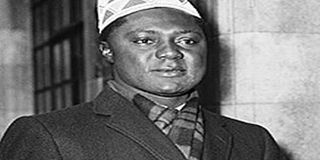The fall and rise of Tanzania’s Kilombero, and Tom Mboya’s fears over Kenya sugar firms

Five months before he was assassinated in 1969, Economic Planning minister Tom Mboya wrote a small note to his agriculture counterpart, Bruce McKenzie, expressing his fears over Kenya’s fledgling sugar industry. PHOTO | FILE
What you need to know:
- The fall of Kilombero, funded by International Finance Corporation, an arm of the World Bank, had scared sugar investors in East Africa who were starting to get worried about the mix of politics, price control and profits.
- Like the sugar schemes in Kenya, Kilombero investors realised that the soil was poor despite previous samples indicating that it would be good. The rainfall was also more treacherous than forecast and the road network made transportation of cane almost impossible.
Five months before he was assassinated in 1969, Economic Planning minister Tom Mboya wrote a small note to his agriculture counterpart, Bruce McKenzie, expressing his fears over Kenya’s fledgling sugar industry.
“My dear Bruce,” Mboya wrote, “you will be interested to see the attached press. I hope a similar headline will not be written about Muhoroni.”
The headline referred to a cutting of an article by Lawrence Fellows of the New York Times detailing the collapse of Tanzania’s expansive Kilombero Sugar Company. The fall of Kilombero, funded by International Finance Corporation, an arm of the World Bank, had scared sugar investors in East Africa who were starting to get worried about the mix of politics, price control and profits.
One of the largest sugar estates in the region, Kilombero spread over both banks of the Great Ruaha River, and had, since it started operating in October 1962, recorded “one disastrous loss after another”, according to the New York Times article.
In order to sustain Kilombero, with its expensive overhead irrigation structure, Mwalimu Julius Nyerere’s government decided to subsidise its operations by fixing the price of sugar at almost twice what it would have cost to import the commodity. But despite this subsidy, the investors demanded more after their net accumulated loss reached $1.5 million, meaning they had no money to develop the sugar estate.
The Nyerere government not only refused to give them the requested subsidy, but also cut the fixed price of sugar to $129 a tonne, which was the price it was paying the Moshi-based, rain-fed Tanganyika Planting Company.
TRANSPORT PROBLEMS
Kilombero, therefore, was turning into a grave mistake in sugar enterprise. While the government had promised the investors some support, this was not forthcoming and when they started making losses, they demanded that Nyerere raises the fixed price of sugar, buys the investors out, or “writes off Kilombero as a mistake”.
Nyerere nationalised the company following the 1969 Arusha Declaration and brought in a Dutch management team to oversee the project. Like the sugar schemes in Kenya, Kilombero investors realised that the soil was poor despite previous samples indicating that it would be good. The rainfall was also more treacherous than forecast and the road network made transportation of cane almost impossible.
Tanzania was holding onto this company because it was employing more than 3,500 people, and so it continued to subsidise its activities until 1998, when the firm was sold to South Africa’s Illovo Sugar Company.
It was this balance between offering employment and sustaining an expensive sugar project that worried Mboya. Today, the once loss-making Kilombero is Tanzania’s largest sugar estate, covering 23,000 acres, of which 10,000 are under an outgrowers scheme. That means that most of the Kilombero cane comes from its own plantations, unlike in Kenya, where most of the cane comes from smallholder farmers.
A day after McKenzie received Mboya’s note, he received another letter from Vice-President Daniel arap Moi complaining that “sugarcane planted 30 months ago, and which should have been cut over a year ago, has not been cut due to transport problems”.
Moi was seeking McKenzie’s help in getting the army to transport sugarcane to Chemelil, which was having difficulties of oversupply. This appears to have been a common problem in the sugar belt, and even to date it has never been resolved.
Mboya’s fears seem to have been right on the money, after all.





